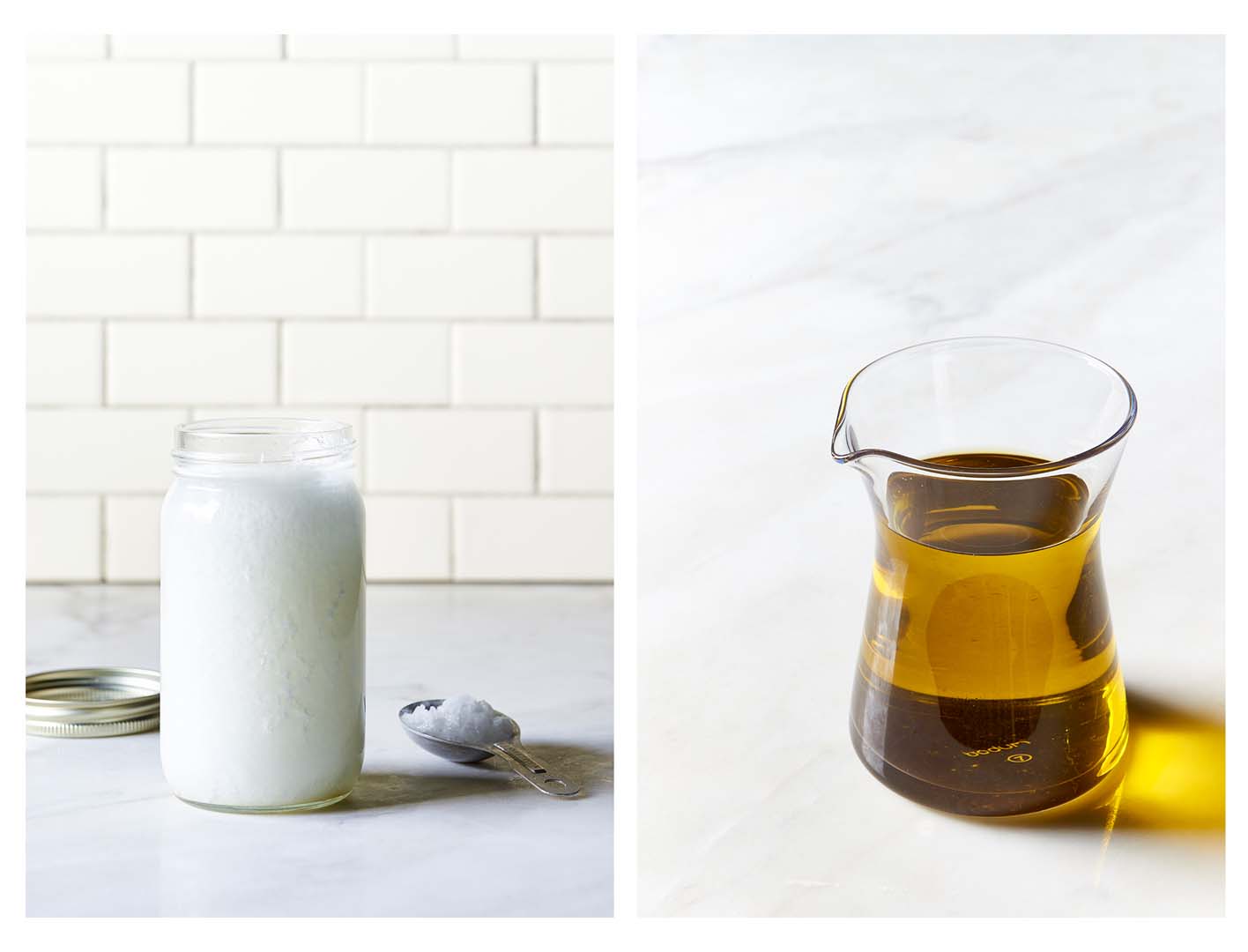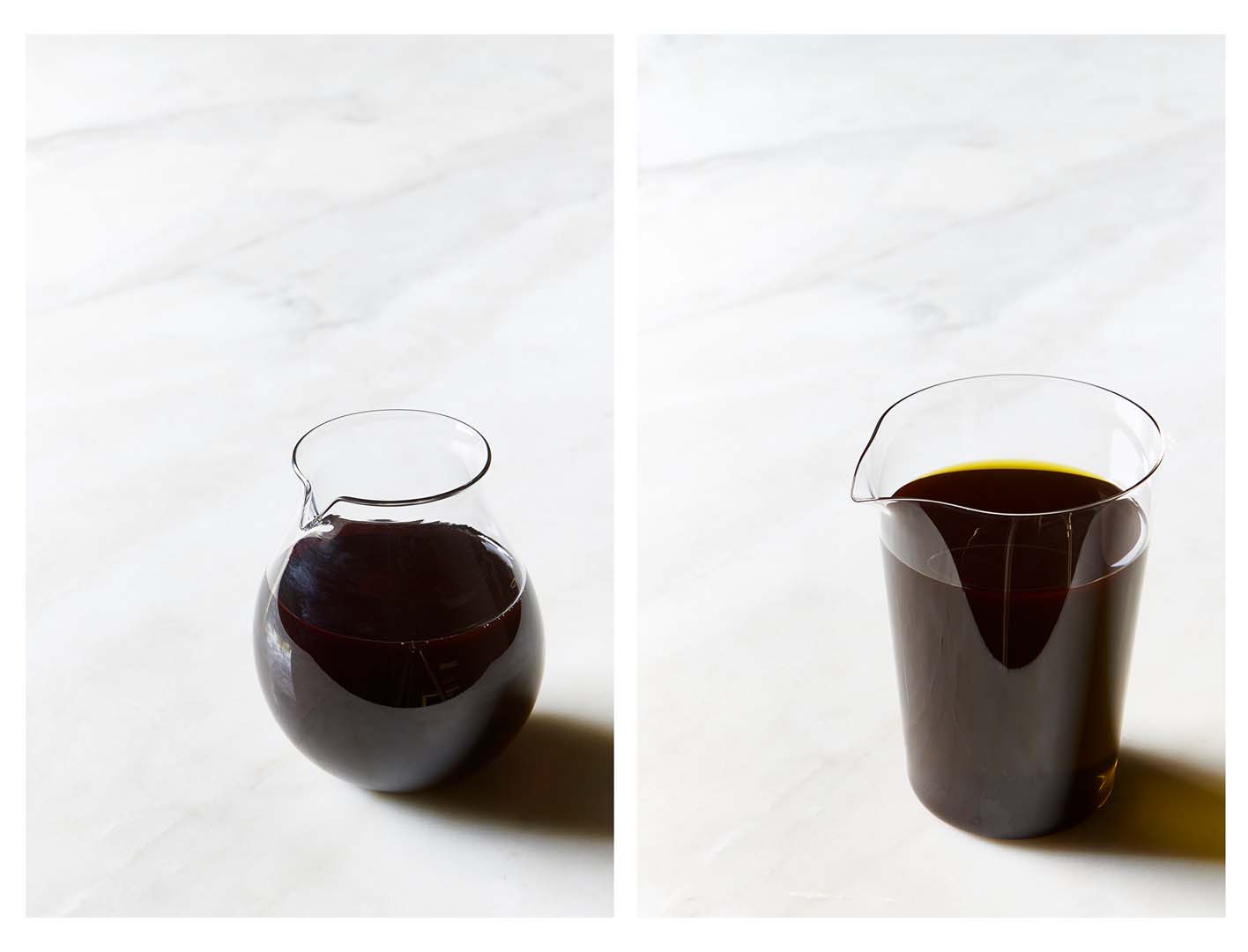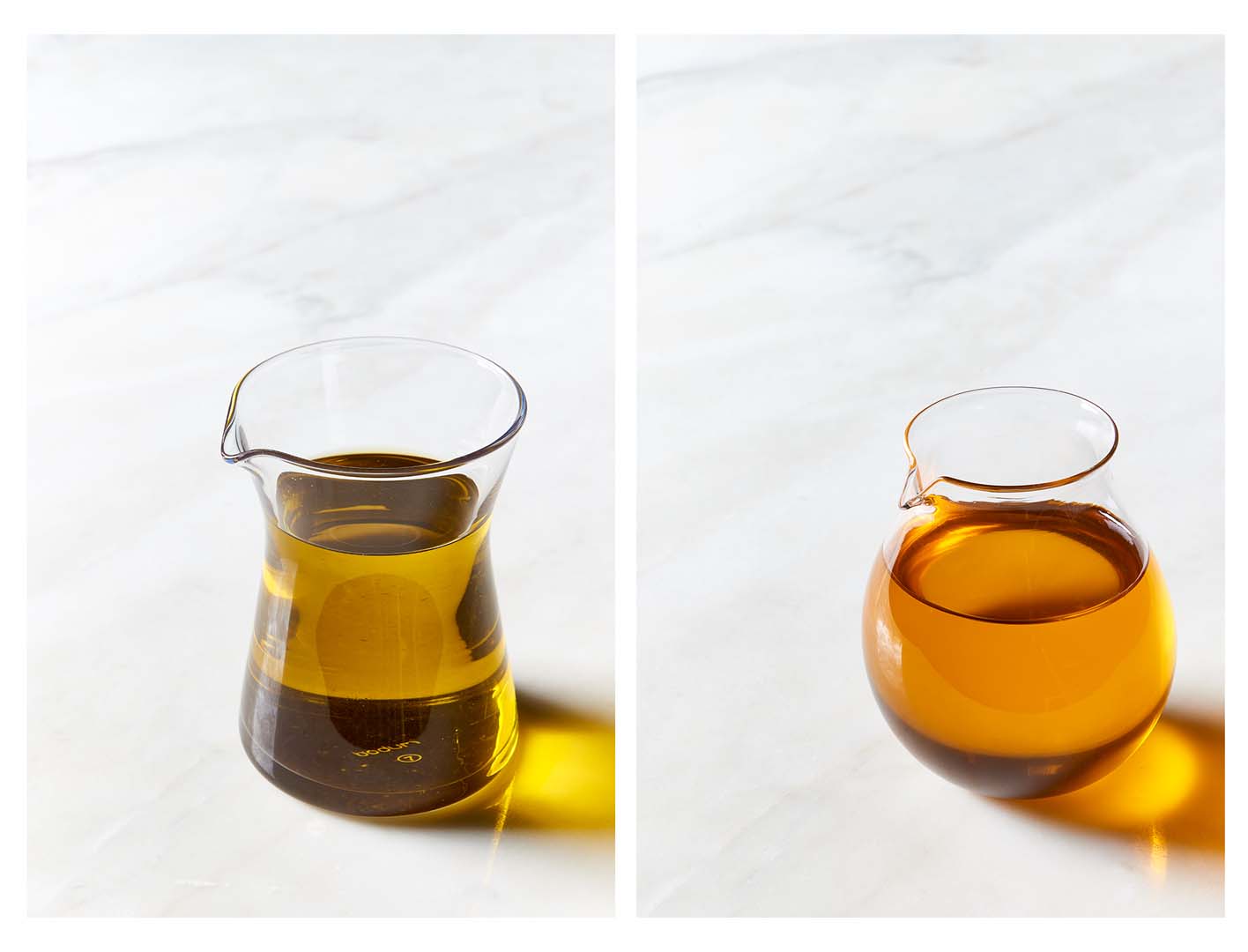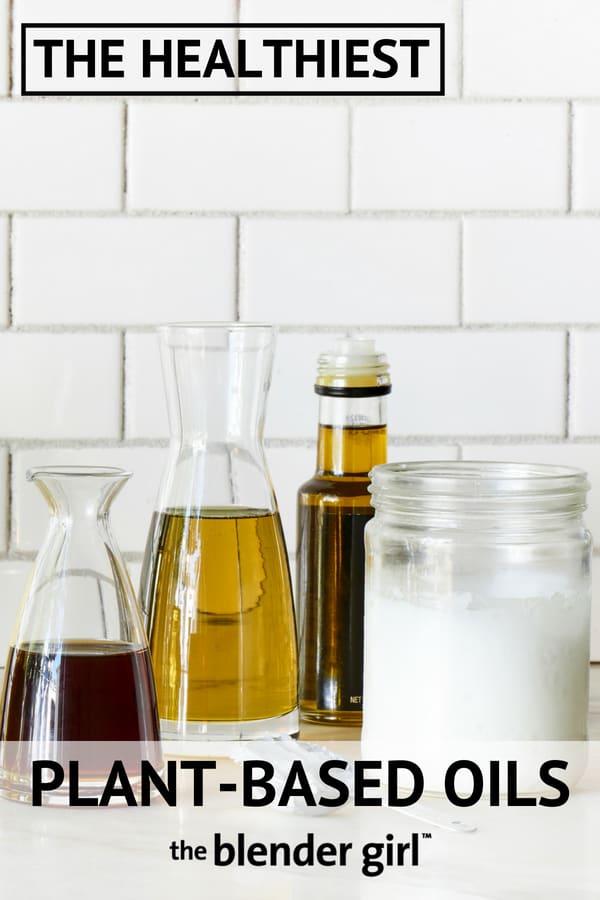Healthy Oils
Tips for selecting, storing, cooking, and using coconut oil, olive oil, avocado oil, grape seed oil, and more to create delicious recipes.
Healthy Oils
Thank goodness we're now in an era where the word is out: Quality plant-based fats and oils are not just good for us, they’re essential for optimal health.
The term “low fat" made famous by the commercial food industry is clever marketing. But, these foods typically substitute fats with sugar. Very often, low fat food packaged foods are not health-promoting.
With healthy oils, choose quality sources in appropriate quantities.
Plant-based oils can be used as part of a balanced diet. But, still, we can get too much of a good thing.
The best fats come as part of whole foods where the fats are eaten with the other nutrients and fiber of the food.
However, I do use plant-based oils in my recipes, and these are the ones I use most often.

Choose good quality oils
The types of fats and oils we consume are vital to our overall health.
We crave fats because they satiate us, insulate our bodies, and make food taste delicious.
Good quality organic, cold pressed, expeller pressed, and unrefined oils can support health. But it is important that oils be of premium quality. Look for oils that are as close to their natural source with minimal processing.
I consume a variety of these good quality plant-based oils. My choice of oil for a given recipe is dependent on two things: the temperature the oil will be exposed to, and the flavor profile of the dish. I want an oil that will complement the natural character of the bare ingredients, and can withstand the temperature of cooking.
Certain oils such as hemp oil and flax seed oil should never be heated.
How to store oils
Always store oils in dark, light-proof bottles in a cool dark place to prevent oxidation and rancidity. Shelf life varies depending on the oil.
Oils are not like fine wines. They do not improve with age. Once you open a fresh bottle of oil use it within one month to three months depending on the oil.
Don’t save expensive oils for use on special occasions like that outfit you’ll never wear that is now out of fashion and still has the tags on.
With oils: Use them or lose them.
Cooking with oils
I heat oils as little as possible. If I'm making a stir-fry, I start with a little bit of water and then stir through the oil at the end, in order to get the and delicious flavor of the oil without heating it too much.
A great rule is, “Your nose knows”! If an oil smells rancid, it is. Toss it. Generally, good quality oils can only be heated to moderate temperatures until fragrant before being compromised. Lower quality oils that have been chemically processed and hydrogenated boast higher smoke points. But this is because they have been stripped of their nutrients. Steer clear of these cheap oils.
Coconut oil is the only oil that can withstand extreme temperatures. Olive oil, sesame oil and grape seed oil can be heated to moderate temperatures, and I rarely heat any other oils.
I bake with grape seed and rice bran oil.
I never heat flax oil, hemp oil, pumpkin seed oil, avocado oil, or macadamia oil.

Coconut Oil
The health benefits of coconut oil have been well documented.
Solid at co0l temperatures and liquid at warmer temps, coconut oil is the healthiest oil to cook with if you're heating foods at extreme temperatures. Coconut oil is the only oil that is not adversely altered by heat. It can be heated to very high temperatures and does not go rancid. I always roast my vegetables in coconut oil.
The really good coconut oil is produced within an hour or two after opening the coconut. The oil is extracted using Direct Micro Expelling (DME) equipment and preserves the natural flavor and aroma of the coconut.
Always purchase virgin coconut oil that has not been refined. Any product that smells toasted or rancid needs to be discarded.
Coconut oil has both short and medium chain fatty acids. Coconut butter is absolutely loaded with antibacterial and antiviral properties. It has lauric acid which has a powerful antiviral effect on the body, and caprylic acid which is a potent anti-fungal.
This oil is fantastic for boosting immunity and staving off illness. If I am around anyone who is sick, I hop into the coconut.
Coconut oil has a very strong assertive flavor that can overpower certain dishes.
If you are substituting butter in recipes, start with half the amount, as coconut oil is highly concentrated and contains less water.
I also use coconut oil to moisturize my skin, condition my hair, and will use it in place of sesame oil for oil pulling.
Olive Oil
Extra-virgin olive oil is a staple in my diet. It is incredibly versatile, has a delicious flavor, and has extraordinary health benefits.
Olive oil is rich in monounsaturated fat, which is well documented for helping to lower the risk of heart disease, diabetes, colon cancer and asthma. It can lower cholesterol and blood pressure; assists to balance blood sugar levels; has potent anti-inflammatory effects, powerful antioxidants to combat free radical damage, and supports good gastrointestinal health.
Olive oils come in a variety of flavors. They can be rich and fruity, or light and buttery. They also range in color: from dark green to light gold.
Generally, the deeper the color, the richer the flavor. The color and flavor are dependent on the variety of the olives; the climate and quality of the soil; cultivation and farming practices; and storage techniques.
The labeling of olive oil is important. I am concerned with “first cold-pressed” and “cold-pressed”; and “extra virgin” and “virgin”.
The first press yields the richest flavor, and so on. In some places where they use more advanced technology, really powerful presses are used, and there is only one press that yields a uniform top quality product.
The “virginity” of an olive oil is a measure of the acidity or amount of free oleic acid. Extra virgin olive oil has an acidity of about 1%; and has a deep flavor and color; and strong aroma. Virgin olive oil is slightly more acidic, at up to 2%, and contains less phytonutrients, and is more fruity in flavor, which is not as strong on the nose or the back of the tongue.
I always reserve my most expensive, decadent, and nutrient-rich olive oil for use in raw recipes – salads, dips, sauces, and dressings, and for drizzling on steamed vegetables etc. These luxurious olive oils are best enjoyed raw. Some of the flavor, and a lot of the nutrients are lost as soon as you heat olive oil. So you are wasting your money if you are going to heat it.
Olive oil boasts a moderate heat tolerance. But this is more as a measure of exposure to toxic carcinogens. I recommend heating olive oil as little as possible, to reap the most nutritional rewards and taste sensations.
I do use extra-virgin olive oil for stir-frying. But I usually start frying with filtered water, and then stir through the olive oil at the end after removing from the flame. Then I get the best of both worlds – the raw oil, and the satiation of the cooked food wrapped in oil.
If you're using olive oil in baked goods, try a standard virgin olive oil that has a lighter flavor. Extra-virgin olive oil tend to overpower baked good.
I tend to use other vegetable oils like grape seed oil or rice bran oil for baking. But olive oil is delicious in some savory cakes.
Purchase olive oil that is as fresh as possible from vendors with a high turnover and good suppliers. Olive oils are not like fine wines. They don’t age well.
Choose olive oil packaged in dark, tinted or opaque bottles, and store in a cool dark place. Olive oil goes rancid quickly from exposure to light and heat. Oxidation will compromise the nutritional profile.
As a general rule, once you open a bottle of olive oil it has a shelf life of 6 to 8 weeks. After a few months, the phytonutrient and antioxidant profile begins to drop. So, use it or lose it!
It is so sad when you save that gorgeous artisan olive oil for that special event only to open it and be ripped with rancidity. It's like opening that fine bottle of wine and discovering it's corked!
A good tip if you purchase large quantities of olive oil: Decanter a small amount into a dark bottle and keep at room temperature to minimize the oxidation factor. Leave the rest in a cool dark pantry.
I see a lot of people storing their olive oil beside in gorgeous decanters beside the stove top for easy access or nice presentation. This is not a good idea. The constant exposure to heat compromises the integrity of the oil.

Sesame Oil
This delicious oil is to Asian cuisine what olive oil is to Mediterranean cuisine. Sesame oil is widely used in Indian and Chinese cooking, as well as other South East Asian dishes.
The rich nutty aroma, and gorgeous distinctive flavor of sesame oil is great for accenting and seasoning dishes. I use sesame oil as an accent ingredient rather than a key player unless I want a sesame or Asian flavor profile.
Sesame oil is a great source of polyunsaturated fatty acids such as omega 3, 6 and 9 for supporting heart health diabetes, and arthritis. However, you may want to consume sesame oil in moderation. It has a whopping 120 calories per tablespoon.
Just like olive oil, sesame oil varies in color, flavor and aroma depending on where the oil is produced, the ripening time, and the production techniques.
Raw sesame oil is a pale yellow color and is very mild in flavor. Raw sesame oil is fantastic tossed through steamed or raw vegetables when you want a little richness. For a quick, refreshing raw salad, just toss raw sesame oil with lemon juice, chile, garlic, and sea salt.
Sesame oil boasts a medium heat tolerance. I recommend heating it as little as possible to preserve the valuable phytonutrients and fatty acids. I usually add it end at the end to stir-fries to get that satiated oily flavor without having to heat the precious raw oil.
Indian sesame oil is more golden in color and has a stronger flavor. I will occasionally use this variety for use in Ayurvedic and Indian dishes. The Chinese and Korean sesame oils are a much darker, brown color. They are made with roasted sesame seeds. This yields an oil with a much richer flavor.
Be sure to read labels. As with all other oils, you get what you pay for with sesame oil. There is a lot of manual work involved in “oiling” a sesame seed. Sesame seeds are protected by capsules that only burst upon ripening, complicating the processing time. So, that is why high quality sesame oil is expensive,
Sesame oil contains natural antioxidants and is easily absorbed by the skin making it a fantastic moisturizer if you don’t mind smelling like an Asian takeaway joint!
Grape Seed Oil
High quality grape seed oil is high in bioflavanoids, and antioxidants; and is a rich source of Vitamin E. It is one of the best sources of linoleic acid — one of the essential fatty acids the body cannot produce.
Grape seed oil contains powerful antioxidants to protect against heart disease and free radical damage, and can assist in lowering cholesterol.
This green oil has a mild, clean, neutral flavor that is slightly nutty. Grape seed oil has the lowest saturated fat content of any oil and emulsifies really well, making it deal for use in salad dressings and condiments such as mayonnaise and aioli. I also like to use it stir-fries.
Grape seed oil is a fantastic substitute for butter in vegan baked goods. But using grape seed oil in baked recipes alters the cooking time, with the tops of cakes browning a lot more quickly. The final product tastes a lot milder, too. Often, you will need to add more sweetener, and possibly a little more of the other ingredients in order to balance the flavor profile. You may also need to lower the oven temperature and adjust the cooking time.
Grape seed oil is also fantastic for natural moisturizer for your skin. With its high Vitamin E content it is a great carrier oil for use in aromatherapy blends.
Be careful when purchasing grape seed oil. The wine grapes yield a small amount of oil, and a lot of oil is chemically extracted with added stabilizers.
A note for people with allergies to canola, soy, and sunflower oil: You may also be allergic to grape seed oil. If you have severe food allergies, please consult your allergist before using grape seed oil.

Avocado Oil
Made by pressing the flesh of the avocado, this decadent oil has a similar composition to olive oil. It is rich in monounsaturated fat and low in saturated fat. It also contains no cholesterol.
Cold-pressed avocado oil is a brilliant oil for raw recipes. The divine flesh yields a huge amount of oil with a very low acidity and oxidation. It is rich in vitamin A and E, chlorophyll, and potassium.
Choose cold-pressed avocado oil stored in dark amber or green bottles. Even though this oil is touted as having a very high smoke point of 255 C/491 F, I only ever use it raw. It makes a fantastic base for salad dressings, as an accent in raw desserts, and is fantastic added to smoothies.
I also use avocado oil on my skin or add it to the bath. Avocado oil is also a fantastic carrier oil for aromatherapy massage. Avocado oil is known to be a wonderful natural moisturizer for dry and mature skins, and for soothing itchiness associated with psoriasis and eczema. A lot of people in my family suffer from eczema, and we can personally testify to the wonderful healing properties of avocado oil.
Pumpkin Seed Oil
This exotic oil has traditionally been used in Eastern European cuisines, and is a large export product of Styria (a geographical region of Austria). It is a thick viscous oil, with a light green or amber color and a rich nutty flavor. It is produced by pressing raw or roasted pumpkin seeds. Both varieties are delicious, and fantastic in salad dressings, drizzled on soups and vegetable dishes, and fantastic added to smoothies.
Pumpkin seed oil is rich in zinc; Vitamins A, C and E; and is also loaded with polyunsaturated fatty acids which are fragile and destroyed when heated.
Cooked pumpkin seed oil has a bitter taste. To get the most bang for your buck use it raw.
I got some fantastic recipes on a trip to Eastern Europe years ago. I had some incredible salad dressings and sauces made with pumpkin seed oil, honey, and apple cider vinegar.
Top tip from the Eastern Europeans: Pumpkin seed oil is absolutely delicious as a nutty accent drizzled on ice creams, yoghurts, creams, puddings, and desserts!
The Styrian pumpkin variety has been exported to Australia and it is thriving. So Australia is now producing some phenomenal pumpkin seed oils.
Macadamia Oil
Produced by extracting the meat of the raw macadamia nut this rich and decadent oil is largely monounsaturated. has a similar composition to olive oil, and is widely used as a substitute.
Macadamia oil has a light amber color and a slight nutty fragrance. It is touted as having a higher smoke point than olive oil and good for frying. But the incredibly nutritious oils and acids in this gorgeous oil are fragile. As with olive oil and sesame oil, I do not recommend heating it. But rather, stirring it through raw before serving.
I always buy cold-pressed organic macadamia oil, store it in a dark place, and only use it raw recipes or as an accent ingredient drizzled on cooked soups and vegetables.
Macadamia oil is also a great natural moisturizer for your skin as it is an incredibly rich source of palmitoleic acid which is close to the natural oil in our skin.
The high monounsaturated fat and antioxidant content helps prevent oxidation giving it a longer shelf life than a lot of other oils. But always store in dark, tinted bottles in a cool, dark pantry to preserve this precious beauty.
Pistachio Oil
This exotic and expensive oil has a very intense powerful flavor that does not go with everything.
As with all nut oils, it tastes very similar to the flesh from which it was extracted. So if you don’t want a pistachio flavor in your dish look elsewhere!
Having said that, it is a fantastic accent oil perfect for finishing off that special dessert, salad, or veggie dish. It also works really well in Middle Eastern pastries and cookies.
I only use raw pistachio oil and never heat it. But, I will drizzle a tiny bit on my steamed vegetables which is divine!
Pistachio oil is high in monounsaturated fatty acids like oleic acid, and is an excellent source of antioxidants such as Vitamin E.
Pistachio oil is also a great natural moisturizer for your skin, and makes a fantastic carrier oil for massage and aromatherapy.

Hemp Oil
Flax Seed Oil







